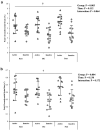Habitual exercise influences carotid artery strain and strain rate, but not cognitive function in healthy middle-aged females
- PMID: 36637510
- PMCID: PMC10119229
- DOI: 10.1007/s00421-022-05123-x
Habitual exercise influences carotid artery strain and strain rate, but not cognitive function in healthy middle-aged females
Abstract
Purpose: Aging females are at risk of declining vascular and cognitive function. Exercise can augment both factors independently; however, the influence of exercise on their interdependence is less clearly understood. Ultrasound speckle tracking is a sensitive novel measure of arterial aging but has not previously been used in middle-aged females. We aimed to elucidate the potential interactions between vascular and cognitive variables in active aging females.
Methods: Twelve active (56 ± 5 years; [Formula: see text]: 34.5 ± 6.1 ml.kg.min-1) and 13 inactive (57 ± 4 years; 22.8 ± 2.6 ml.kg.min-1) healthy middle-aged females were included. Ultrasound speckle tracking assessed short-axis common carotid artery (CCA) compliance via peak circumferential strain (PCS) and strain rate (PSR) at rest, during, and after 3-min isometric handgrip exercise. Flow-mediated dilation (FMD) of the brachial artery was assessed using ultrasound. Cognitive function was measured using Verbal Fluency, Trail Making, Stroop, and Digit Span tests.
Results: PCS (P = 0.003) and PSR (P = 0.004), were higher in the active cohort. FMD was similar between groups (P > 0.05). Minimal differences in cognitive function existed between groups, although the inactive group performed better in one test of animal Verbal Fluency (P < 0.01). No associations were observed between PCS, PSR, or FMD with cognitive function (all P > 0.05).
Conclusion: This is the first study to assess PCS and PSR in middle-aged females and demonstrates that active middle-aged females exhibit a superior carotid artery profile compared to their inactive counterparts. However, PCS and PSR of the carotid artery may not be linked with cognitive function in middle-aged females.
Keywords: Aging; Carotid function; Cognitive function; Exercise; Flow-mediated dilation; Speckle tracking.
© 2023. Crown.
Conflict of interest statement
The authors have no competing interests to declare. No funding was received for conducting this study.
Figures




Similar articles
-
Resistance- and endurance-trained young men display comparable carotid artery strain parameters that are superior to untrained men.Eur J Appl Physiol. 2025 Jan;125(1):131-144. doi: 10.1007/s00421-024-05598-w. Epub 2024 Oct 3. Eur J Appl Physiol. 2025. PMID: 39361034 Free PMC article.
-
The influence of habitual endurance exercise on carotid artery strain and strain rate in young and middle-aged men.Exp Physiol. 2020 Aug;105(8):1396-1407. doi: 10.1113/EP088384. Epub 2020 Jul 8. Exp Physiol. 2020. PMID: 32578897
-
Carotid artery wall mechanics in young males with high cardiorespiratory fitness.Exp Physiol. 2018 Sep;103(9):1277-1286. doi: 10.1113/EP087067. Epub 2018 Aug 1. Exp Physiol. 2018. PMID: 29959801
-
Aerobic exercise, but not isometric handgrip exercise, improves endothelial function and arterial stiffness in patients with myocardial infarction undergoing coronary intervention: a randomized pilot study.BMC Cardiovasc Disord. 2021 Feb 17;21(1):101. doi: 10.1186/s12872-021-01849-2. BMC Cardiovasc Disord. 2021. PMID: 33596832 Free PMC article. Clinical Trial.
-
Preserved vascular reactivity in elderly male athletes.Scand J Med Sci Sports. 1999 Apr;9(2):88-91. doi: 10.1111/j.1600-0838.1999.tb00214.x. Scand J Med Sci Sports. 1999. PMID: 10220842
Cited by
-
Involvement of Melatonin, Oxidative Stress, and Inflammation in the Protective Mechanism of the Carotid Artery over the Torpor-Arousal Cycle of Ground Squirrels.Int J Mol Sci. 2024 Nov 29;25(23):12888. doi: 10.3390/ijms252312888. Int J Mol Sci. 2024. PMID: 39684599 Free PMC article.
-
Proton-Sensing G Protein-Coupled Receptors and Their Potential Role in Exercise Regulation of Arterial Function.Biomolecules. 2025 Jun 4;15(6):813. doi: 10.3390/biom15060813. Biomolecules. 2025. PMID: 40563452 Free PMC article. Review.
-
Resistance- and endurance-trained young men display comparable carotid artery strain parameters that are superior to untrained men.Eur J Appl Physiol. 2025 Jan;125(1):131-144. doi: 10.1007/s00421-024-05598-w. Epub 2024 Oct 3. Eur J Appl Physiol. 2025. PMID: 39361034 Free PMC article.
References
-
- Aichberger M, Busch M, Reischies F, et al. Effect of physical inactivity on cognitive performance after 2.5 years of follow-up: longitudinal results from the survey of health, ageing, and retirement (SHARE) J Gerontopsychology Geriatr Psychiatry. 2010;23:7–15. doi: 10.1024/1662-9647/a000003. - DOI
-
- Azhim A, Akioka K, Akutagawa M, et al (2007) Effects of aging and exercise training on the common carotid blood velocities in healthy men. In: 2007 29th Annual International Conference of the IEEE Engineering in Medicine and Biology Society. IEEE, Lyon, France, pp 989–993 - PubMed
MeSH terms
LinkOut - more resources
Full Text Sources
Miscellaneous

